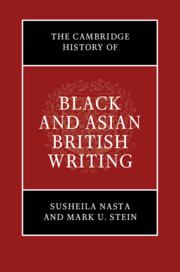Book contents
- The Cambridge History of Black and Asian British Writing
- The Cambridge History of Black and Asian British Writing
- Copyright page
- Dedication
- Contents
- Notes on Contributors
- Preface and Acknowledgements
- Introduction
- Part I New Formations
- Part II Uneven Histories
- Part III Writing the Contemporary
- (I) Looking Back, Looking Forward
- 26 Diasporic Translocations
- 27 Reinventing the Nation
- 28 Reclaiming the Past
- 29 Expanding Realism, Thinking New Worlds
- 30 Writing Lives, Inventing Selves
- 31 Black and Asian British Women’s Poetry
- (II) Framing New Visions
- Select Bibliography
- Index
26 - Diasporic Translocations
Many Homes, Multiple Forms
from (I) - Looking Back, Looking Forward
Published online by Cambridge University Press: 19 December 2019
- The Cambridge History of Black and Asian British Writing
- The Cambridge History of Black and Asian British Writing
- Copyright page
- Dedication
- Contents
- Notes on Contributors
- Preface and Acknowledgements
- Introduction
- Part I New Formations
- Part II Uneven Histories
- Part III Writing the Contemporary
- (I) Looking Back, Looking Forward
- 26 Diasporic Translocations
- 27 Reinventing the Nation
- 28 Reclaiming the Past
- 29 Expanding Realism, Thinking New Worlds
- 30 Writing Lives, Inventing Selves
- 31 Black and Asian British Women’s Poetry
- (II) Framing New Visions
- Select Bibliography
- Index
Summary
Questions of accommodation, home and belonging, exile, migrancy and diaspora recur across the history of black and Asian writing from the eighteenth century to the present. Following the publication of key works such as Salman Rushdie’s The Satanic Verses (1988), Hanif Kureishi’s The Buddha of Suburbia (1990), and V. S. Naipaul’s The Enigma of Arrival (1987), it was increasingly clear that the figure of the migrant was beginning to be seen both as the ‘Everyman’ of the late modern period – a cultural traveller able to traverse a number of shifting national, political and ethnic boundaries – and as a figure already well versed in negotiating the demands of a new transnational and global world. Focusing on some of these seminal texts as well as fictions by a later generation of British migrant writers (such as, Abdulrazak Gurnah, Sunetra Gupta, Monica Ali, and Caryl Phillips), this chapter explores how these writers’ mixed identities and plural literary perspectives began to herald a wider recognition of Britain as a racially mixed postcolonial nation, at the same time marking a sea change in the form, style, range, and geography of British fiction.
- Type
- Chapter
- Information
- The Cambridge History of Black and Asian British Writing , pp. 437 - 452Publisher: Cambridge University PressPrint publication year: 2020

